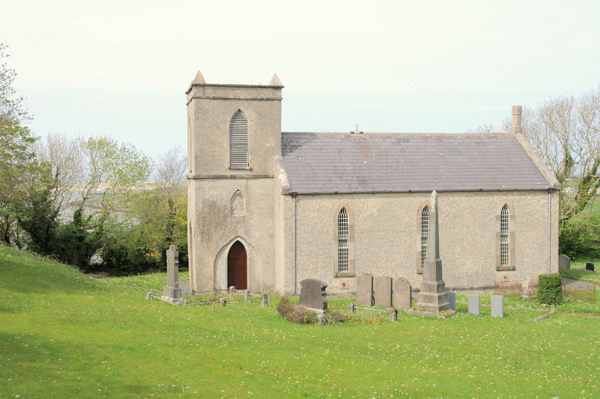Clooney, "the meadow", is a large parish in the Waterside of Londonderry. In ancient times, there was a chapel of Clooney in Glendermott parish. This was rebuilt before 1600, but was in ruins in 1692. A perpetual curacy was established in Glendermott parish for Clooney district in 1863. James Murray of Caw, Londonderry, granted a site for the church, which was dedicated to All Saints in 1867.
Clooney Church is well sited above the east bank of the River Foyle in the Waterside, at the hairpin bend junction of Bond's Hill and Clooney Terrace. The tower in the north west corner is surmounted by a short octagonal spire. The spire is flanked at its base by four small steep pyramids. Beneath it, steps descend to Bond's Hill below. On the Bond's Hill north side of the church at basement level, are three blind arcades. Round the corner from the west wall with its imposing west door entrance, is a porch which protrudes from the south aisle. The refurbishment of the entrance stonework is in memory of Isobel Lowry, 1983. The list of Rectors of Clooney in the porch was donated by Dick and Dorothy Harvey, 1979. The little window on the left of the porch depicts St. Patrick with a shamrock, and the window opposite depicts St. Columba. These were installed during further renovations in 2000.

The interior of the church is most impressive, as indeed is the whole building. The central nave is flanked by two arcaded aisles with short transepts contained within the line of the east end of the aisles. Three marble steps lead into the chancel, beyond which is a three sided sanctuary. Beneath the north aisle, there is a basement which contains choir vestries and other prayer rooms.
There is a small prayer desk at the west door which commemorates James Gibbons, 1969. Above the west door, there is a rose window. Above that are two stained glass windows, and over them, again a single single circular window in the apex of the roof. In the west wall of the south aisle, there is a small window of coloured glass, depicting a dove, and beside it a window depicting praying hands, the gift of the McCorkell family. On the other side of the west wall, a window depicts The Good Shepherd in memory of Thomas and Margaret Alexander and their parents, George and Mary, 1968. The baptistery is at the west end of the north aisle. The window in it depicts Jesus gathering the little children, 1898. There are two pairs of windows in the north aisle. The first pair is of opaque diamond glass. the first of the second pair is in memory of soldiers of the 5th Londonderry Battalion of the Ulster Defence Regiment who were killed of who died between 1970 and 1992. It contains the city crest and the badge of the U.D.R., and the Bible. The other window has opaque diamond glass. In the south aisle, there are also two pairs of windows. The first pair has one window which was presented by the Brownies to mark sixty years of their existence in the parish, 1932-1992. Their motto, "lend a hand" is inscribed. The other window is of opaque diamond glass, as are both windows in the neighbouring pair. The nave and aisles are separated by four arches above which are three clerestory windows of two lights on each side. The window in the south transept contains various figures in stained glass, and has tracery above. It commemorates Henry Lane, 1894. The opposite window in the north transept illustrates the "Nunc Dimittis", (St. Luke 2:29-32) on the left, and, "behold the Lamb of God", on the right. The left section is in memory of the Rev. Edward Stewart who died in 1883, and the right section commemorates his son, the Rev. John Stewart, Vicar of Clooney, 1872-1880. The three windows in the sanctuary have two lights each, and are inserted in the three sections of the apsidal east sanctuary wall. Each window has three levels. The twelve Apostles are depicted in the top two levels, and there are various Biblical scenes in the bottom levels. Memorial inscriptions at the base of the whole window record that it was erected in memory of W. S. Harvey, who died in 1870, to the Glory of God at the desire of and by the bequest of James Nesbitt. It is altogether, a magnificent set of stained glass windows. Round the base of the sanctuary is a fine marble reredos.

The altar is finely carved. Two of the four chairs in the sanctuary are in memory of Canon William Garstin, Curate of Clooney, 1905-1908, and Rector, 1914-1920. The prayer desk in the sanctuary is in memory of Mary Campbell, 1958. There is a prayer desk at each end of the choir stalls. The vestry room is to the left of the chancel, and the organ chamber is on the right. The organ is of two manuals and pedals, and its detached console is in the north aisle.
The pulpit on the right is of brown marble. The small prayer desk beside it was made in 1996. A small font adjacent commemorates James Moore who died in 1987.
The two memorials to those of the parish who fell and served in the Great War and in the second World War are on the east wall of the north transept. A monument on the north wall of the north aisle commemorates Lt. William Gilliland of the Royal Inniskilling Fusiliers, who was killed at Galipoli in 1915. Margaret Gilliland who died in 1938, and Joseph Cooke who died in 1918 are commemorated on other memorials on the same wall. On the south wall of the south aisle, there is a memorial to Sgt. Major John Lowry who died in 1936, and a memorial to Martha Plummer who died in 1940.













